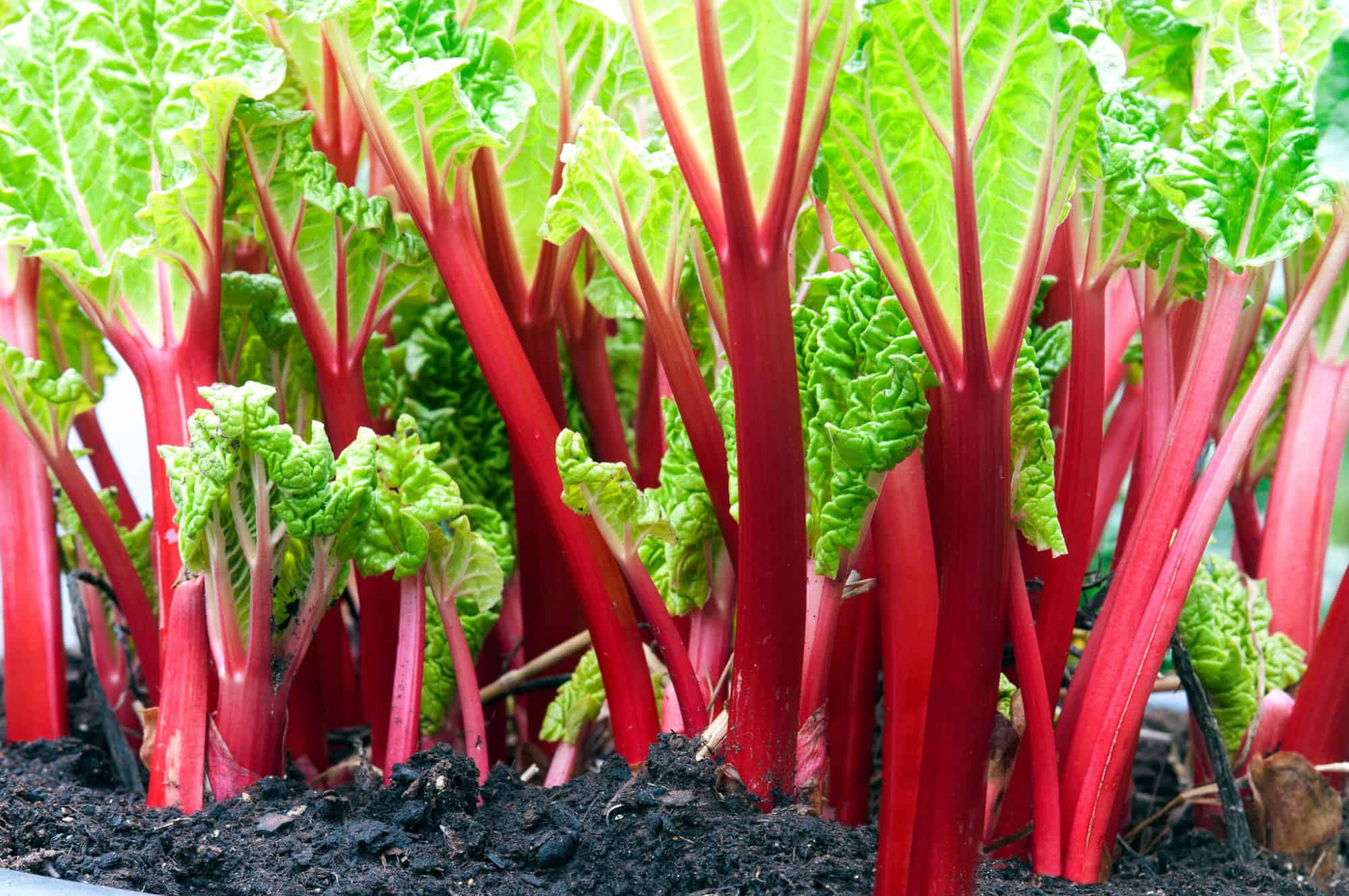Discovering when rhubarb is in peak season across the U.S. becomes an exciting journey for all food enthusiasts. As the vibrant stalks of this tart and tangy vegetable awaken gardens and markets nationwide, a multitude of delectable possibilities emerge for culinary exploration. In this article, we delve into the enchanting realm of rhubarb’s seasonal availability throughout different regions in the United States. By exploring its cultivation timelines from coast to coast, readers can savor the anticipation of indulging in mouthwatering pies, jams, and refreshing beverages that only fresh rhubarb can offer during its prime harvest time. So fasten your seatbelts as we embark on a flavorful expedition uncovering when and where this versatile ingredient reaches its finest form across our nation.
What is Rhubarb?
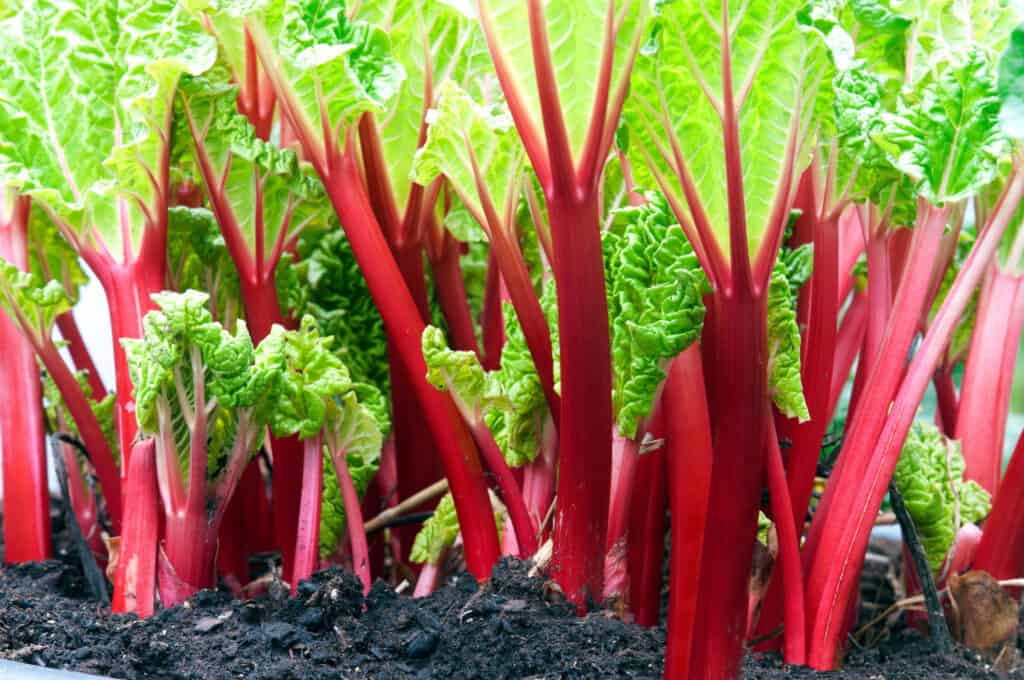
The peak season for rhubarb is in the spring months in the U.S.
©HVPMdev/Shutterstock.com
Rhubarb is an early-season perennial vegetable. It has a sour taste when eaten raw, but when cooked, it adds a pleasant tartness to your dish. It can be used in both sweet and savory recipes and is especially delicious when paired with strawberries. This herb is usually thought of as a fruit for cooking purposes and grows in stiff stalks with leafy tops similar to celery. The stalks are edible and have a characteristic tart flavor that pairs well with the sweetness of strawberries. Many people also enjoy munching on raw rhubarb dipped in sugar! Rhubarb is typically ripe in springtime, making it a popular seasonal favorite.
Rhubarb Peak Season

This delicious food grows best in the northern United States because it needs a period of chill.
©Marika Kosheleva/Shutterstock.com
Rhubarb has its peak season in various regions across the United States. In general, rhubarb is in peak season from March through June. Among these regions, the Northern U.S., particularly Oregon, and Washington, thrive in rhubarb production. They have favorable climate and soil conditions and a long peak season. As spring unfurls its vibrant colors, late March to early April marks the arrival of the first field-grown rhubarb from these states.
Moving eastward to Wisconsin, May becomes an exciting time for rhubarb enthusiasts as fresh stalks begin gracing local markets and gardens. This delightful availability lasts through late June, when summer’s warmth is at its zenith. Similarly, in Michigan, residents eagerly anticipate the emergence of fresh field-grown or homegrown rhubarb starting in late April. As May approaches with blossoming flowers dotting landscapes across the state, this delectable produce continues captivating taste buds until June.
Where Does Rhubarb Grow?
Rhubarb grows best in northern climates where temperatures remain below 40° F, as this stimulates growth. It typically comes into peak season in late April or early May and can be harvested throughout the summer.
In southern areas that don’t experience freezing temperatures, rhubarb can be grown as an annual. But hot weather can cause it to die or produce thin, skeletal leaf stalks that lack color.
Rhubarb can be successfully grown as an annual in subtropical and tropical climates. But only if they have a cool production period. It is hardy in USDA Hardiness Zones 3 through 8. It can reliably produce for 10 years as a perennial plant in these zones.
When to Plant
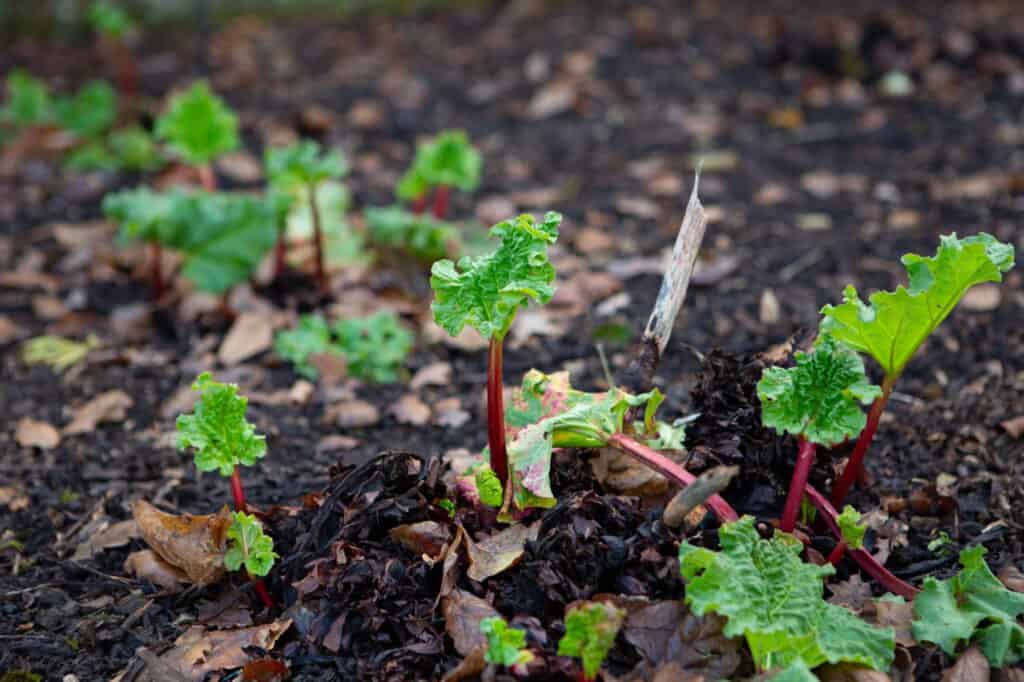
Rhubarb needs to be thinned as it grows.
©Jess Gregg/Shutterstock.com
Rhubarb can be planted in either late fall or early spring. Planting crowns in the fall will result in rhubarb cropping in the spring. When planting in the spring, make sure to do so as soon as the soil is workable and before root growth begins. A soil temperature of 50°F or above is ideal.
To plant rhubarb, first, dig a hole that is 8-10 inches deep. Place the crown in the hole and fill it with soil, making sure to cover the top of the crown. Give the plant at least two feet of space between itself and other plants. Water the area and mulch around the base of the plant.
If planting multiple crowns, space them at least three feet apart. Apply a layer of compost or fertilizer around the base of the plant. Keep the soil moist and weed free.
Rhubarb is a perennial plant, meaning it will come back year after year. Once it has taken root, it will require minimal maintenance. Prune the plant in late summer to promote growth the following spring. When harvesting rhubarb, only take a few stalks at a time to ensure the plant is not over-harvested.
Planting Tips
When it comes to planting rhubarb, use 1-year-old rhubarb crowns rather than starting from seeds. These crowns can be easily found at garden centers and nurseries or even ordered online for convenience. It’s important to note that while growing from seed is possible, it is not the recommended method due to its potential challenges.
Before planting your rhubarb crowns, take the time to eliminate any perennial weeds in the chosen planting site. This will help ensure that your rhubarb plants have a clean and healthy environment in which they can thrive.
When preparing the holes for planting, aim for a size similar to that of a bushel basket. This will allow enough space for the roots of each plant and promote optimal growth. The spacing between individual rhubarb plants should be around 2 to 4 feet apart, with approximately 3 to 4 feet of distance between rows.
When placing the crowns into the prepared holes, make sure that their eyes are positioned about 2 inches below the surface of the soil. Additionally, ensure that buds are facing upwards, as this will aid in proper growth and development.
Lastly, remember to water your newly planted rhubarb thoroughly immediately after planting. Providing adequate moisture at this stage will help establish strong root systems. These deep roots will support overall plant health as they begin their journey toward maturity.
By following these planting tips when introducing your rhubarb into its new home, you’ll be well on your way toward enjoying rhubarb during its peak season.
How to Grow
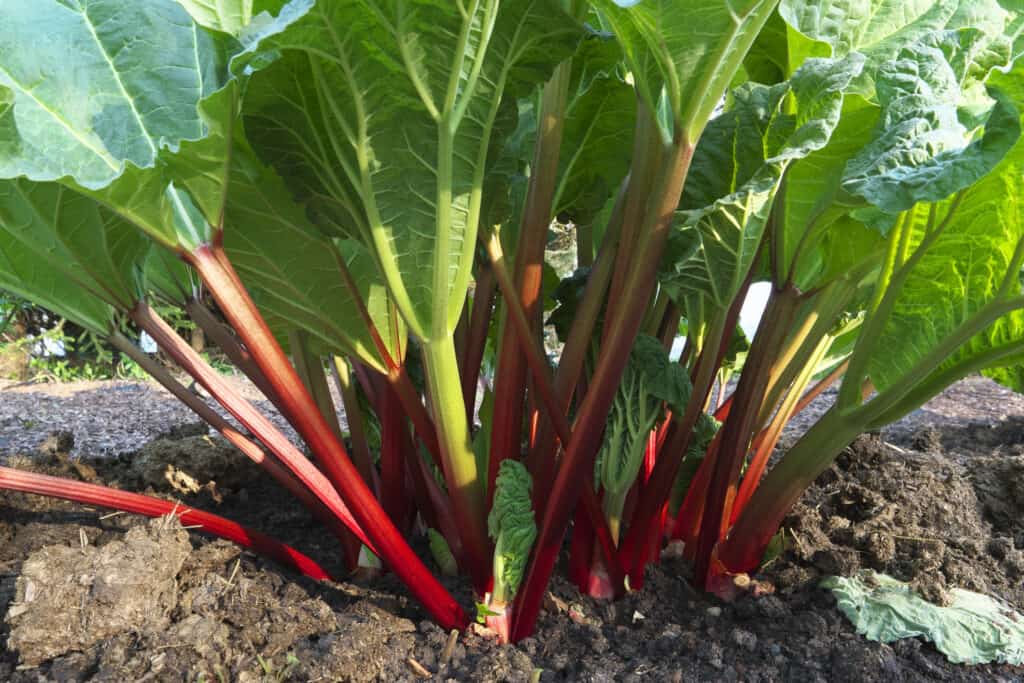
Rhubarb enjoys steady fertilizer and organic mulch.
©iStock.com/veger
Crowding of rhubarb can cause stunted growth, so it’s important to dig and split the roots regularly. The best time to divide the plants is during the very early spring or late fall when they are dormant. Each division should have at least one big bud. Cover with a thick layer of straw to trap moisture and stop weeds from taking over. Make sure to water your plant adequately, especially during the hot summer months.
Once the ground has thawed in the spring, give your rhubarb plants a light dusting of fertilizer (10-10-10) and remove any seed stalks that may have appeared. In the fall, eliminate all dead plant material. As the soil starts to freeze, add 2-4 inches of organic mulch, such as well-rotted compost, to the area. This will help add nitrogen to the ground and ensure a successful growing season for your rhubarb plants.
When and How to Harvest
Wait until the third year to begin harvesting rhubarb stalks. Doing so in the first two years will hinder the plant’s growth. Once the third year is reached, you can harvest for 8 to 10 weeks until mid-summer. Be sure to only take stalks that are 12 to 18 inches long and at least 3/4 inches thick. If the stalks become thin, it is a sign that the plant is running low on reserves, so refrain from harvesting.
To harvest rhubarb, pull the stalk away from the plant with a gentle twist. If that doesn’t work, use a sharp knife to cut the stalk at the base. Remember to sanitize the knife before cutting to avoid spreading diseases. Always leave two stalks per plant to ensure a long-term harvest of over 10 years.
People used to think that during the summer, the whole rhubarb plant would become poisonous with the rising temperatures. This is not accurate. However, stalks typically have a rougher texture if you collect them in the summertime versus those harvested during the spring. Therefore, it is best to let the stalks remain on the plant after July so they can get energy for the following year’s development.
How to Store Rhubarb During Peak Season
During the peak season of rhubarb, it is not uncommon to find yourself with an abundance of this tangy and versatile vegetable. But fear not, as there are several simple yet effective methods to help you store the excess and enjoy its vibrant flavors all year round.
One option for storing rhubarb is to cut the stalks into manageable pieces and refrigerate them in a covered container. This method ensures that the rhubarb remains fresh and crisp for up to a couple of weeks, allowing you ample time to incorporate it into your favorite recipes.
Alternatively, if you prefer a more protective approach, tightly wrapping the stalks in either plastic or aluminum foil before placing them in the refrigerator can provide an extra layer of insulation against moisture loss or potential odors from other foods. This technique helps maintain the quality of your rhubarb for extended periods without compromising its delightful tartness.
For those looking for long-term storage options, freezing is an excellent solution. Simply cut the rhubarb stalks into smaller pieces and place them in a covered container or zip-type plastic bag before transferring them to your freezer. When stored properly at freezing temperatures, frozen rhubarb can retain its flavor and texture for approximately one year.
How to Use Rhubarb
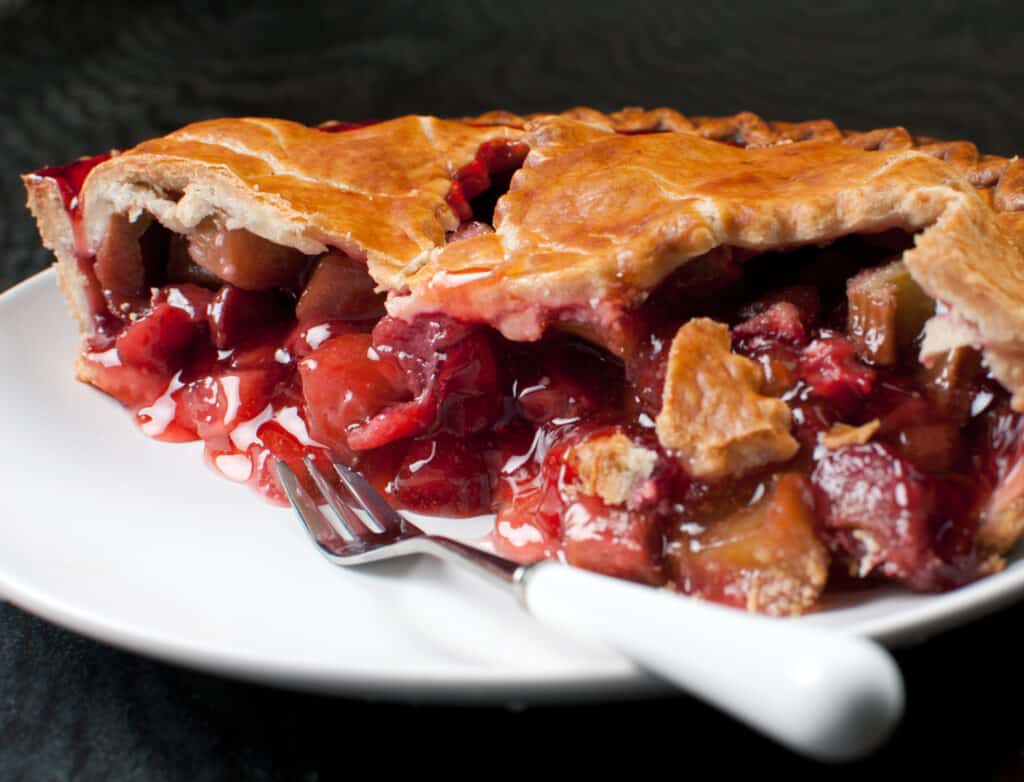
Strawberry and rhubarb pie is one of the most common ways to use rhubarb during peak season.
©iStock.com/razmarinka
Rhubarb, with its vibrant red stalks and unique tartness, is a versatile ingredient that can be used in various culinary creations. Whether you’re an experienced cook or a novice in the kitchen, here are three common ways to utilize rhubarb’s wonderful flavors during peak rhubarb season.
Rhubarb Pies
One of the most popular uses for rhubarb is undoubtedly in pies. The tangy flavor of rhubarb pairs beautifully with sweet ingredients like strawberries or raspberries, making for a perfect balance of taste. A classic recipe involves combining chopped rhubarb with sugar and other fruits if desired, encasing the mixture within a flaky pie crust, and baking it until the filling becomes tender and bubbling. This beloved dessert captures the essence of springtime with every bite.
Rhubarb Compotes
If you’re seeking a simpler way to enjoy rhubarb’s distinctive taste without all the fuss of pastry-making, consider preparing a flavorful compote. By stewing diced rhubarb gently on low heat along with sugar and perhaps some spices like cinnamon or ginger, you can create a luscious sauce-like consistency bursting with a tanginess that complements both sweet and savory dishes alike. Serve this compote over yogurt or ice cream for an indulgent treat, or use it as an accompaniment to roasted meats for an unexpected burst of flavor.
Rhubarb Cocktails
For those looking to incorporate rhubarbs into their cocktails, there are numerous ways to do so. The tart and tangy flavor of rhubarb adds a refreshing twist to traditional cocktail recipes, making them perfect for summer gatherings or any occasion. One popular option is the classic Rhubarb Collins, a variation of the well-known Tom Collins cocktail. To make this delightful drink, simply muddle fresh rhubarb with sugar in a shaker until it forms a juicy paste. Then add gin, lemon juice, and ice before shaking vigorously and straining into a glass filled with crushed ice. Garnish with a stalk of fresh rhubarb or a lemon twist for an elegant touch.
Thank you for reading! Have some feedback for us? Contact the AZ Animals editorial team.

